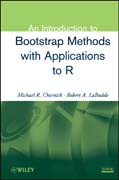
An introduction to bootstrap methods with applications to R
Chernick, Michael R.
LaBudde, Robert A.
This book provides both an elementary and a modern introduction to the bootstrap for students who do not have an extensive background in advanced mathematics. It offers reliable, hands-on coverage of the bootstrap's considerable advantages - as well as its drawbacks. The book outpaces the competition by skillfully presenting results on improved confidence set estimation, estimation of error rates in discriminant analysis, and applications to a wide variety of hypothesis testing and estimation problems. To alert readers to the limitations of the method, the book exhibits counterexamples to the consistency of bootstrap methods. The authors take great care to draw connections between the more traditional resampling methods and the bootstrap, oftentimes displaying helpful computer routines in R. Emphasis throughout the book is on the use of the bootstrap as an exploratory tool including its value in variable selection and other modeling environments. ÍNDICE: List of Tables. 1. Introduction. 1.1 Historical Background. 1.2 Definition and Relationship to the Delta Method and Other Resampling Methods. 1.3 Wide Range of Applications. 1.4 The Bootstrap and the R Language System. 1.5Historical Notes. 1.6 Exercises. 1.7 References. 2. Estimation. 2.1 Estimating Bias. 2.2 Estimating Location. 2.3 Estimating Dispersion. 2.4 Linear Regression. 2.5 Nonlinear Regression. 2.6 Nonparametric Regression. 2.7 Historical Notes. 2.8 Exercises. 2.9 References. 3. Confidence Intervals. 3.1 Subsampling, Typical Value Theorem and Efrons Percentile Method. 3.2 Bootstrap T. 3.3 Iterated Bootstrap. 3.4 Bias Corrected Bootstrap. 3.5 BCa and ABC. 3.6 Tilted Bootstrap. 3.7 Variance Estimation with Small Sample Sizes. 3.8 Historical Notes. 3.9 Exercises. 3.10 References. 4. Hypothesis Testing. 4.1 Relationship to Confidence Intervals. 4.2 Why Test Hypotheses Differently? 4.3 Tendril DX Example.4.4 Klingenberg Example: Binary Dose Response. 4.5 Historical Notes. 4.6 Exercises. 4.7 References. 5. Times Series. 5.1 Forecasting Methods. 5.2 Time Domain Models. 5.3 Can Bootstrapping Improve Prediction Intervals? 5.4 Model BasedMethods. 5.5 Block Bootstrapping for Stationary Time Series. 5.6 Dependent Wild Bootstrap. 5.7 Frequency Based Approaches for Stationary Time Series. 5.8 Sieve Bootstrap. 5.9 Historical Notes. 5.10 Exercises. 5.11 References. 6. Bootstrap Variants. 6.1 Bayesian Bootstrap. 6.2 Smoothed Bootstrap. 6.3 ParametricBootstrap. 6.4 Double Bootstrap. 6.5 The M Out-of N Bootstrap. 6.6 The Wild Bootstrap. 6.7 Historical Notes. 6.8 Exercise. 6.9 References. 7. Chapter Special Topics. 7.1 Spatial Data. 7.2 Subset Selection in Regression. 7.3 Determining the Number of Distributions Censored Data. 7.4 Censored Data. 7.5 pValue Adjustment. 7.6 Bioequivalence. 7.7 Process Capability Indices. 7.8 Missing Data. 7.9 Point Processes. 7.10 Bootstrap to Detect Outliers. 7.11 Lattice Variables. 7.12 Covariate Adjustment of Area Under the Curve Estimates for ROC Curves, 7.13 Bootstrapping in SAS. 7.14 Historical Notes. 7.15 Exercises. 7.16 References. 8. When the Bootstrap is Inconsistent & How to Remedy It. 8.1 Too Smallof a Sample. 8.2 Distributions with Infinite Second Moments. 8.3 Estimating Extreme Values. 8.4 Survey Sampling. 8.5 M-Dependent Sequences. 8.6 Unstable autoregressive Processes. 8.7 Long-Range Dependence. 8.8 Bootstrap Diagnostics. 8.9 Historical Notes. 8.10 Exercises. 8.11 References.
- ISBN: 978-0-470-46704-6
- Editorial: John Wiley & Sons
- Encuadernacion: Cartoné
- Páginas: 208
- Fecha Publicación: 16/09/2011
- Nº Volúmenes: 1
- Idioma: Inglés
